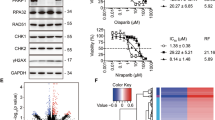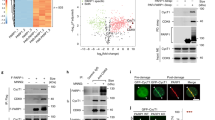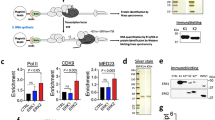Abstract
The transcription factor E2F-1 is implicated in the activation of S-phase genes as well as induction of apoptosis, and is regulated by interactions with Rb and by cell cycle-dependent alterations in E2F-1 abundance. We earlier demonstrated a pivotal role for poly(ADP-ribose) polymerase-1 (PARP-1) in the regulation of E2F-1 expression and promoter activity during S-phase re-entry when quiescent cells re-enter the cell cycle. We now investigate the putative mechanism(s) by which PARP-1 may upregulate E2F-1 promoter activity during S-phase re-entry. DNase-1 footprint assays with purified PARP-1 showed that PARP-1 did not directly bind the E2F-1 promoter in a sequence-specific manner. In contrast to p53, a positive acceptor in poly(ADP-ribosyl)ation reactions, E2F-1 was not poly(ADP-ribosyl)ated by wild-type PARP-1 in vitro, indicating that PARP-1 does not exert a dual effect on E2F-1 transcriptional activation. Protein-binding reactions and coimmunoprecipitation experiments with purified PARP-1 and E2F-1, however, revealed that PARP-1 binds to E2F-1 in vitro. More significantly, physical association of PARP-1 and E2F-1 in vivo also occurred in wild-type fibroblasts 5 h after re-entry into S phase, coincident with the increase in E2F-1 promoter activity and expression of E2F-1-responsive S-phase genes cyclin A and c-Myc. Mapping of the interaction domains revealed that full-length PARP-1 as well as PARP-1 mutants lacking either the catalytic active site or the DNA-binding domain equally bind E2F-1, whereas a PARP-1 mutant lacking the automodification domain does not, suggesting that the protein interaction site is located in this central domain. Finally, gel shift analysis with end-blocked E2F-1 promoter sequence probes verified that the binding of PARP-1 to E2F-1 enhances binding to the E2F-1 promoter, indicating that PARP-1 acts as a positive cofactor of E2F-1-mediated transcription.
This is a preview of subscription content, access via your institution
Access options
Subscribe to this journal
Receive 50 print issues and online access
$259.00 per year
only $5.18 per issue
Buy this article
- Purchase on Springer Link
- Instant access to full article PDF
Prices may be subject to local taxes which are calculated during checkout







Similar content being viewed by others
Abbreviations
- DMEM:
-
Dulbecco's modified Eagle's medium
- FBS:
-
fetal bovine serum
- MRC:
-
multiprotein DNA replication complex
- PARP:
-
poly(ADP-ribose) polymerase
- PAR:
-
poly(ADP-ribose)
- PBS:
-
phosphate-buffered saline
- PCNA:
-
proliferating-cell nuclear antigen
- pol:
-
DNA polymerase
- RFC:
-
replication factor C
- RPA:
-
replication protein A
- BRCT:
-
breast cancer susceptibility protein C-terminus
References
Akiyama T, Takasawa S, Nata K, Kobayashi S, Abe M, Shervani N, Ikeda T, Nakagawa K, Unno M, Matsuno S and Okamoto H . (2001). Proc. Natl. Acad. Sci. USA, 98, 48–53.
Alkhatib HM, Chen DF, Cherney B, Bhatia K, Notario V, Giri C, Stein G, Slattery E, Roeder RG and Smulson ME . (1987). Proc. Natl. Acad. Sci. USA, 84, 1224–1228.
Ame J, Rolli V, Schreiber V, Niedergang C, Apiou F, Decker P, Muller S, Hoger T, de Murcia J and de Murcia G . (1999). J. Biol. Chem., 274, 17860–17868.
Anderson M, Scoggin K, Simbulan-Rosenthal C and Steadman J . (2000). J. Virol., 74, 2169–2177.
Blake M and Azizkhan J . (1989). Mol. Cell. Biol., 9, 4994–5002.
Buki K, Bauer P, Hakam A and Kun E . (1995). J. Biol. Chem., 270, 3370–3377.
Butler A and Ordahl C . (1999). Mol. Cell. Biol., 19, 296–306.
Cervellera M and Sala A . (2000). J. Biol. Chem., 275, 10692–10696.
Cherney BW, McBride OW, Chen DF, Alkhatib H, Bhatia K, Hensley P and Smulson ME . (1987). Proc. Natl. Acad. Sci. USA, 84, 8370–8374.
Critchlow S, Bowater R and Jackson S . (1997). Curr. Biol., 7, 588–598.
de Capoa A, Febbo F, Giovanelli F, Niveleau A, Zardo G, Marenzi S and Caiafa P . (1999). FASEB J., 13, 89–93.
DeGregori J, Leone G, Miron A, Jakoi L and Nevins J . (1997). Proc. Natl. Acad. Sci. USA, 94, 7245–7250.
Desmarais Y, Menard L, Lagueux J and Poirier GG . (1991). Biochim. Biophys. Acta, 1078, 179–186.
Furuno N, den Elzen N and Pines J . (1999). J. Cell Biol., 147, 295–306.
Galande S and Kowhi-Shigematsu T . (1999). J. Biol. Chem., 274, 20521–20528.
Ha H, Hester L and Snyder S . (2002). Proc. Natl. Acad. Sci. USA, 99, 3270–3275.
Hassa P, Covic M, Hasan S, Imhof R and Hottiger M . (2001). J. Biol. Chem., 276, 45588–45597.
Hassa P and Hottiger M . (1999). Biol. Chem., 380, 953–959.
Johansson M . (1999). Genomics, 57, 442–445.
Johnson D, Cress W, Jakoi L and Nevins J . (1994a). Proc. Natl. Acad. Sci. USA, 91, 12823–12827.
Johnson D, Ohtani K and Nevins J . (1994b). Genes & Dev., 8, 1514–1525.
Johnson D, Schwaz J, Cress W and Nevins J . (1993). Nature, 365, 349–352.
Kannan P, Yu Y, Wankhade S and Tainsky M . (1999). Nucleic Acids Res., 27, 866–874.
Kawaichi M, Ueda K and Hayaishi O . (1981). J. Biol. Chem., 256, 9483–9489.
Kawamitsu H, Hoshino H, Okada H, Miwa M, Momoi H and Sugimura T . (1984). Biochemistry, 23, 3771–3777.
Kickhoefer V, Siva A, Kedersha N, Inman E, Ruland C, Streuli M and Rome L . (1999). J. Cell. Biol., 146, 917–928.
Kim H, Jacobson M, Rolli V, Menissier-de Murcia J, Reinbolt J, Simonin F, Ruf A, Schulz G and de Murcia G . (1997). Biochem. J., 322, 469–475.
Knudsen E and Wang J . (1997). Mol. Cell. Biol., 17, 5771–5783.
Lam E, Bennett J and Watson R . (1995). Gene, 160, 277–281.
Lee D, Kim J, Kim K, Joe C, Schrieber V, Menissier-de Murcia J and Choe J . (2002). Oncogene, 21, 5877–5885.
Marzio G, Wagener C, Gutierrez M, Cartwright P, Helin K and Giacca M . (2000). J. Biol. Chem., 275, 10887–10892.
Masson M, Niedergang C, Schreiber V, Muller S, Menissier-de Murcia J and de Murcia G . (1998). Mol. Cell. Biol., 18, 3563–3571.
Meisterernst M, Stelzer G and Roeder R . (1997). Proc. Natl. Acad. Sci. USA, 94, 2261–2265.
Menissier-de Murcia J, Molinete M, Gradwohl G and de Murcia G . (1989). J. Mol. Biol., 210, 229–233.
Nashh R, Caldecott K, Barnes D and Lindahl T . (1997). Biochemistry, 36, 5207–5211.
Neuman E, Flemington E, Sellers W and Kaelin W . (1994). Mol. Cell. Biol., 14, 6607–6615.
Nevins J . (1992). Science, 258, 424–429.
Nie J, Sakamoto S, Song D, Qu Z, Ota K and Taniguchi T . (1998). FEBS Lett., 424, 27–32.
Nirodi C, NagDas S, Gygi S, Olson G, Aebersold R and Richmond A . (2001). J. Biol. Chem., 276, 9366–9374.
Oei S, Griesenbeck J, Schweiger M and Ziegler M . (1998). J. Biol. Chem., 273, 31644–31647.
Oliver F, Mennisier-de Murcia J, Nacci C, Decker P, Andriantsitohaina R, Muller S, de la Rubia G, Stoclet J and de Murcia G . (1999). EMBO J., 18, 4446–4454.
Pagano M, Peperkok R, Verde F, Ansorge W and Draetta G . (1992). EMBO J., 11, 961–971.
Pearson B, Nasheuer H and Wang T . (1991). Mol. Cell. Biol., 11, 2081–2095.
Qin X, Livingston D, Kaelin W and Adams P . (1994). Proc. Natl. Acad. Sci. USA, 91, 10918–10922.
Rawling J and Alvarez-Gonzalez R . (1997). Biochem. J., 324, 249–253.
Rosenthal DS, Ding R, Simbulan-Rosenthal CMG, Cherney B, Vanek P and Smulson ME . (1997). Nucleic Acids Res., 25, 1437–1441.
Shan B, Farmer A and Lee W . (1996). Cell Growth Differ., 7, 689–697.
Shieh WM, Ame JC, Wilson M, Wang ZQ, Koh D, Jacobson M and Jacobson E . (1998). J. Biol. Chem., 273, 30069–30072.
Simbulan-Rosenthal C, Rosenthal D, Luo R, Samara R, Jung M, Dristchilo A, Spoonde A and Smulson M . (2001). Neoplasia, 3, 179–188.
Simbulan-Rosenthal C, Rosenthal D, Luo R and Smulson ME . (1999a). Oncogene, 18, 5015–5023.
Simbulan-Rosenthal CM, Ly DH, Rosenthal DS, Konopka G, Luo R, Wang Z-Q, Schultz P and Smulson M . (2000). Proc. Natl. Acad. Sci. USA, 97, 11274–11279.
Simbulan-Rosenthal CM, Rosenthal DS, Boulares AH, Hickey RJ, Malkas LH, Coll JM and Smulson ME . (1998a). Biochemistry, 37, 9363–9370.
Simbulan-Rosenthal CM, Rosenthal DS, Iyer S, Boulares AH and Smulson ME . (1998b). J. Biol. Chem., 273, 13703–13712.
Simbulan-Rosenthal CM, Rosenthal DS, Luo R and Smulson ME . (1999b). Cancer Res., 59, 2190–2194.
Simbulan-Rosenthal CMG, Rosenthal DS, Hilz H, Hickey R, Malkas L, Applegren N, Wu Y, Bers G and Smulson M . (1996). Biochemistry, 35, 11622–11633.
Slansky J, Li Y, Kaelin W and Farnham P . (1993). Mol. Cell. Biol., 13, 1610–1618.
Smith S, Giriat I, Schmitt A and de Lange T . (1998). Science, 282, 1395–1397.
Smulson ME, Pang D, Jung M, Dimtchev A, Chasovskikh S, Spoonde A, Simbulan-Rosenthal C, Rosenthal D, Yakovlev A and Dritschilo A . (1998). Cancer Res., 58, 3495–3498.
Tang A, Wu K, Hashimoto T, Liu W, Takahashi R, Shi X, Mihara K, Zhang F, Chen Y and Du C . (1989). Oncogene, 4, 401–407.
van den Heuvel S and Harlow E . (1993). Science, 262, 2050–2054.
Wang ZQ, Auer B, Stingl L, Berghammer H, Haidacher D, Schweiger M and Wagner EF . (1995). Genes Dev., 9, 509–520.
Weinberg R . (1995). Cell, 81, 323–330.
Wesierska-Gadek J, Wojciechowski J and Schmid G . (2003). J. Cell. Biochem., 89, 220–232.
Yamane K, Katayama E and Tsuruo T . (2001). Oncogene, 20, 2859–2867.
Zhang Z, Hildebrandt E, Simbulan-Rosenthal C and Anderson M . (2002). Virology, 296, 107–116.
Acknowledgements
We thank Dr ZQ Wang (IARC, Lyon, France) for the immortalized wild-type and PARP-1−/− cells, Dr Alexander Spoonde for the recombinant wild-type and mutant PARP-1. This work was supported by grants (CA25344 and PO1 CA74175) to MES from the National Cancer Institute, the US Air Force Office of Scientific Research (AFOSR-89-0053) to MES, and the US Army Medical Research and Development Command contract DAMD17-90-C-0053 to MES and DAMD17-00-C-0026 to DSR.
Author information
Authors and Affiliations
Corresponding author
Rights and permissions
About this article
Cite this article
Simbulan-Rosenthal, C., Rosenthal, D., Luo, R. et al. PARP-1 binds E2F-1 independently of its DNA binding and catalytic domains, and acts as a novel coactivator of E2F-1-mediated transcription during re-entry of quiescent cells into S phase. Oncogene 22, 8460–8471 (2003). https://doi.org/10.1038/sj.onc.1206897
Received:
Revised:
Accepted:
Published:
Issue Date:
DOI: https://doi.org/10.1038/sj.onc.1206897
Keywords
This article is cited by
-
Poly(ADP-ribose) Polymerase 1 (PARP1) restrains MyoD-dependent gene expression during muscle differentiation
Scientific Reports (2020)
-
Ribosomal protein uL3 targets E2F1 and Cyclin D1 in cancer cell response to nucleolar stress
Scientific Reports (2019)
-
Poly(ADP-ribosyl)ation of OVOL2 regulates aneuploidy and cell death in cancer cells
Oncogene (2019)
-
Role of mitochondria in rescuing glycolytically inhibited subpopulation of triple negative but not hormone-responsive breast cancer cells
Scientific Reports (2019)
-
PARP1 activation increases expression of modified tumor suppressors and pathways underlying development of aggressive hepatoblastoma
Communications Biology (2018)



